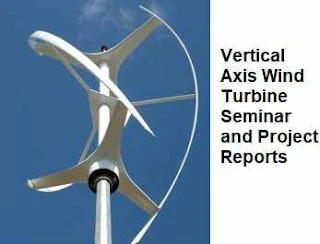Seminar Topic: Vertical Axis Wind Turbine (VAWT)
This article will help you to understand the concept and design of the Vertical Axis Wind Turbine. Download Vertical Axis Wind Turbine Seminar Report with abstract and relevant PDF journals. Also, get project reports and PPT which will guide you to understanding and design your Vertical Axis Wind Turbine project.
Vertical Axis Wind Turbine Seminar Report
Download the PDF seminar report titled discuss the designs and operations of various types of Vertical axis wind turbines. Vertical axis wind turbines are advocated as being capable of catching the wind from all directions and do not need yaw mechanisms, rudders, or downwind coming. Their electrical generators can be positioned close to the ground, and hence easily accessible. A disadvantage is that some designs are not self-starting.
The PDF Seminar Report further discusses two distinct types of vertical axis wind turbines: The Darrieus and the Savonius types. The Darrleus rotor was researched and developed extensively by Sandia National Laboratories in the USA in the 1980s. New concepts of vertical axis wind machines are being introduced such as the helical types particularly for use in urban environments where they would be considered safer due to their lower rotational speeds avoiding the risk of blade ejection and since they can catch the wind from all directions.
Vertical Axis Wind Turbine Project Reports
We have also uploaded DIY projects along with the PDF seminar reports, which will help you in building your own Vertical axis wind turbines. The project report titled Vertical Axis Wind Turbine Evaluation and Design studied the potential for installing a roof-mounted vertical axis wind turbine
(VAWT) systems on house roofs. The project designed several types of VAWT blades with the goal of maximizing the efficiency of a shrouded turbine. The project also used a wind simulation software program, WASP, to analyze existing wind data measured on the roofs of various WPI buildings. Scale-model tests were performed in the WPI closed-circuit wind tunnel. An RPM meter and a 12-volt step generator were used to measure turbine rotation speeds and power output at different wind speeds. The project also studied roof mounting systems for turbines that are meant to dissipate vibrations to the roof structure. Turbine vibrations were measured during the wind tunnel tests and in impact tests on a scale-model house. Recommendations were made for future designs of roof-mounted VAWTs.
Another Project report titled Design of a Vertical Wind Turbine to Power LED Street Lights proposed the idea for a wind turbine attaching to existing light posts will allow cities to cut back on the wattage used, at a low cost. The Project report explains the design project objectives and requirements. The Project report shows the different designs of verticle wind turbines that were analyzed and considered.
The PDF Project report Design of Aeroleaf Wind Turbine is about designing and manufacturing a Vertical Axis Wind Turbines VAWT to transfer the wind speed to a rotational motion using these turbines. These turbines will be attached to a manufactured tree that will look like a modern design, which can be installed in and around any public area such as parks, roads, public facilities, or business offices. Aeroleaf Wind Turbines are designed to produce power up to 300 watts for each turbine.
Vertical Axis Wind Turbine PPT Presentation
The objective of Vertical Axis Wind Turbine PPT for the seminar and project is to design, build, and test composite airfoil blades for a wind turbine. The PPT briefly describes the designs, structural analysis, scale model, and fabrication process.
Download Seminar Report, Project Report, and PPT


0 comments